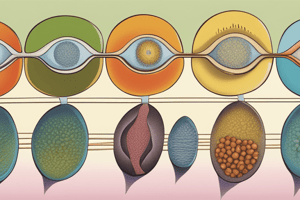Podcast
Questions and Answers
What is the main advantage of sexual reproduction in terms of genetic material?
What is the main advantage of sexual reproduction in terms of genetic material?
- Decreases genetic variation
- Maintains genetic stability
- Reduces the number of chromosomes
- Increases genetic variation (correct)
Which cells are involved in the fusion process during sexual reproduction?
Which cells are involved in the fusion process during sexual reproduction?
- Gametes (correct)
- Somatic cells
- Stem cells
- Red blood cells
What is the purpose of meiosis in sexual reproduction?
What is the purpose of meiosis in sexual reproduction?
- Increase the number of chromosomes
- Facilitate asexual reproduction
- Produce identical offspring
- Reduce the number of chromosomes (correct)
How does sexual reproduction reduce the risk of recessive genetic disorders?
How does sexual reproduction reduce the risk of recessive genetic disorders?
What is the primary outcome of the fusion of gametes in sexual reproduction?
What is the primary outcome of the fusion of gametes in sexual reproduction?
Why is enhancing genetic variation important in sexual reproduction?
Why is enhancing genetic variation important in sexual reproduction?
What is the role of sperm cells during fertilization in sexual reproduction?
What is the role of sperm cells during fertilization in sexual reproduction?
How do male insects transfer genetic material to females during reproduction?
How do male insects transfer genetic material to females during reproduction?
What is a key advantage of sexual reproduction?
What is a key advantage of sexual reproduction?
In mammals, where does fertilization occur?
In mammals, where does fertilization occur?
What is the purpose of the zygote in sexual reproduction?
What is the purpose of the zygote in sexual reproduction?
Why does sexual reproduction take more time than asexual reproduction?
Why does sexual reproduction take more time than asexual reproduction?
Flashcards are hidden until you start studying
Study Notes
Reproduction: Exploring Sexual Reproduction
Reproduction is a fundamental process that allows life to persist and evolve. In this exploration, we'll focus on sexual reproduction, where two parents contribute genetic material to create offspring that inherit a blend of their traits.
Fundamentals of Sexual Reproduction
Sexual reproduction involves the fusion of gametes – egg cells (ova) from the female and sperm cells (spermatozoa) from the male – to produce a zygote. The zygote contains a unique, merged set of genetic information from both parents, representing a new individual. Sexual reproduction benefits organisms by:
- Enhancing genetic variation: The mixing of genetic material from two parents reduces the likelihood of inbreeding and increases the chances of producing offspring with advantageous traits.
- Reducing the risk of disease: Sexual reproduction increases the likelihood that offspring will be free from recessive genetic disorders, as one parent's dominant traits will mask recessive ones in the offspring.
Stages of Sexual Reproduction
Sexual reproduction can be divided into four primary stages:
- Meiosis: The production of gametes begins with meiosis, a cell division process that reduces the number of chromosomes to half the diploid number (2n). Meiosis results in the formation of haploid gametes (n) with half the number of chromosomes as the diploid cells (2n) in the parent organism.
- Fusion of gametes: During fertilization, sperm cells travel through the female reproductive tract to reach the ovum. Once the sperm penetrates the ovum, the sperm head releases enzymes that break down the egg cell's protective coating, allowing fusion of the sperm and egg cells.
- Development of the embryo: After fertilization, the zygote undergoes cell division and development to form an embryo. The embryo grows and develops inside the female reproductive tract, eventually being born or hatching depending on the species.
- Postnatal development: After birth or hatching, the offspring undergo further development, completing their maturation and growth processes.
Sexual Reproduction in Animals
Sexual reproduction occurs in a wide variety of animals, including:
- Insects: Insects, like bees and butterflies, reproduce sexually. Male insects produce spermatozoa, which they transfer to females through a process called copulation. Female insects produce eggs, which are fertilized by the spermatozoa, resulting in the formation of embryos.
- Mammals: Mammals, like humans and elephants, reproduce sexually. Males produce spermatozoa, which are released into the female's reproductive tract during sexual intercourse. Females produce ova, which are fertilized by the spermatozoa in the female reproductive tract.
Challenges and Advantages of Sexual Reproduction
Sexual reproduction presents both challenges and advantages:
- Challenges: Sexual reproduction requires sufficient time for the development of gametes and embryos, increasing the vulnerability of organisms to predation and environmental factors.
- Advantages: Sexual reproduction produces offspring with a wide range of genetic variation, increasing the likelihood of survival and evolutionary success.
Conclusion
Sexual reproduction is a dynamic and complex process that allows for the creation of offspring with a blend of genetic material from both parents. This process results in genetic variation, which enhances the survival and evolutionary success of organisms. Sexual reproduction has been observed across a wide variety of animal groups, contributing to the diverse and robust nature of life on Earth.
Studying That Suits You
Use AI to generate personalized quizzes and flashcards to suit your learning preferences.




